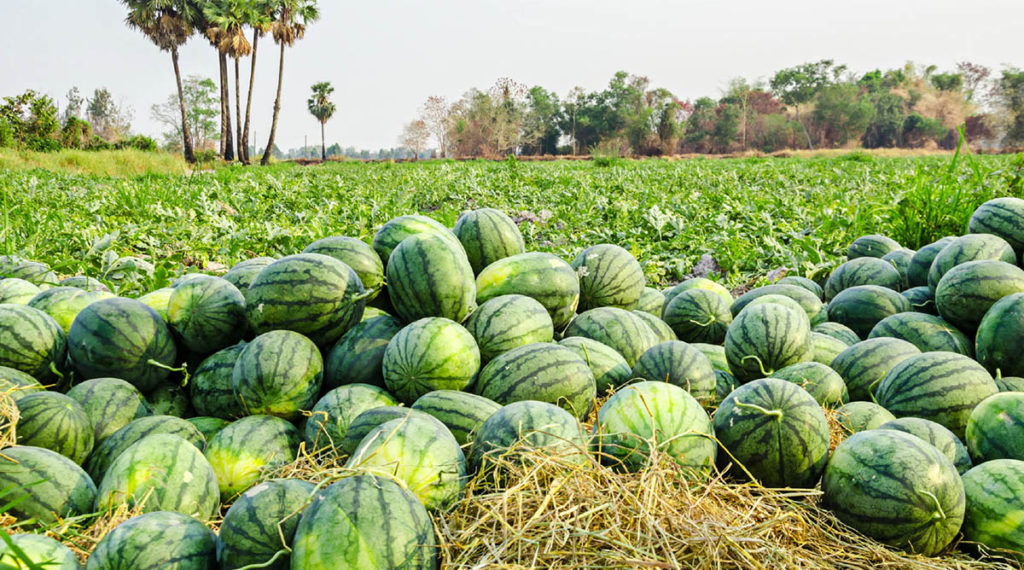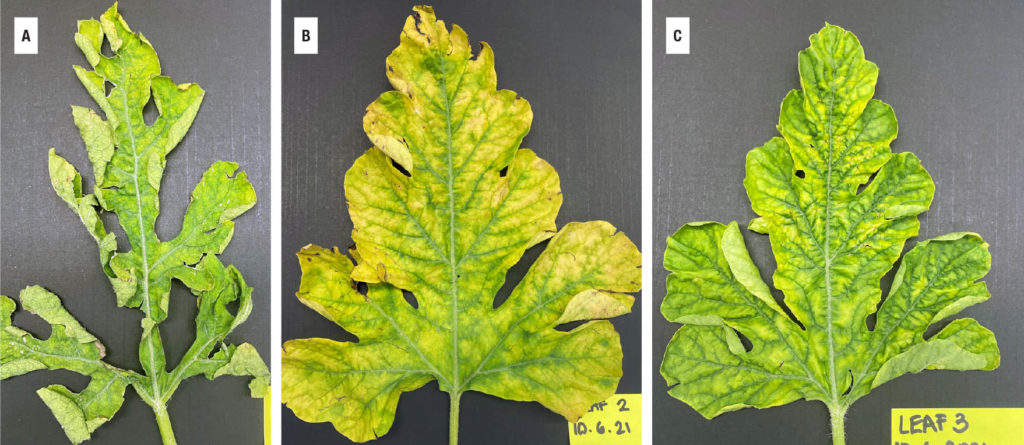By Pamela D. Roberts
Whitefly-transmitted viruses are the major disease problem for watermelons grown in South Florida. For the past few decades, whitefly-transmitted viruses have included squash vein yellowing virus (SqVYV), cucurbit leaf crumple virus (CuLCrV) and cucurbit yellow stunting disorder virus (CYSDV).

A HISTORY OF VIRUSES
Although SqVYV was first identified from squash in Florida in 2005, it had most likely been causing severe losses in watermelon since 2003. The other whitefly-transmitted viruses soon followed. CuLCrV was found in Florida in 2006, and CYSDV was identified in 2007.
In addition to these viruses, aphid-transmitted viruses have been around a long time. Papaya ringspot virus type W (PRSV-W), watermelon mosaic virus (WMV) and zucchini yellow mosaic virus (ZYMV) have been in Florida cucurbits for more than 30 years. Historically, PRSV-W and ZYMV have been more prevalent in South Florida, while WMV was the predominant aphid-transmitted virus occurring in Central and North Florida. Cucumber mosaic virus (CMV), another aphid-transmitted virus, occurs but not as frequently.
Even with all these viruses, South Florida watermelon growers as early as 2017 were expressing concern that there was something new affecting their crops. During a meeting held in Immokalee in December 2017, watermelon growers stated that the virus symptoms seen in the 2016 and 2017 crops were somewhat different from the symptoms typically associated with the known viruses. The symptoms just seemed a bit different.
THREE CULPRITS IDENTIFIED
The growers’ concerns were corroborated when watermelon samples displaying virus symptoms tested negative for any of the commonly found aphid- and whitefly-vectored viruses. However, it was not until spring 2021 that two new viruses were identified in watermelon grown in South Florida.
The two new viruses, watermelon crinkle leaf-associated virus-1 (WCLaV-1) and WCLaV-2, are a completely different virus type unrelated to SqVYV, CuLCrV, CYSDV or the aphid-transmitted viruses. In addition to the new WCLaV-1 and WCLaV-2 viruses, an additional whitefly-vectored virus, cucurbit chlorotic yellows virus (CCYV), was detected in Florida for the first time. It was originally found in North Florida and subsequently in South Florida last year.

SYMPTOMS ARE NOT SIMPLE
Common symptoms caused by viruses can be seen on the leaves as mottling (irregular light and dark areas on leaves) and mosaics (light green and yellow patterns on a leaf). Other common symptoms include leaf distortion by elongating, leaf curling and leaf crumpling.
SqVYV causes yellowing along leaf veins in squash, but symptoms in watermelon are quite different, with only a slight yellowing of the foliage before the plant collapses and dies.
Studies have shown that most plants are infected with more than one virus, so plant symptoms may not be typical for any single virus. Identifying unique symptoms attributed to WCLaV-1 and WCLaV-2 has been difficult due to the mixed infections with other viruses. However, in general, the WCLaV-1 and WCLaV-2 symptoms are leaf crinkling and yellow mosaic patterns. Symptoms of CCYV are similar to CYSDV in that the older leaves turn yellow, and plants may appear to be suffering from nutrient deficiency.
RESEARCH FINDINGS
In 2021, watermelon leaves with virus symptoms were collected and tested for all the viruses. From the more than 100 samples, WCLaV-1 was the predominant virus detected in watermelon in South Florida. WCLaV-1 was found in more than 40% of all leaf samples, and approximately half of these occurred in mixed infections with other viruses. Watermelon samples with WCLaV-1 were widely distributed throughout Florida in Charlotte, Collier, DeSoto, Glades, Osceola, Polk and Seminole counties.
CCYV was found in less than 10% of the samples. All the other viruses were detected but at lower numbers than WCLaV-1.
IMPACTS UNKNOWN
Unfortunately, there are too many unknowns associated with the new viruses to draw any conclusions regarding the actual impact their presence is having on watermelon crops in South Florida. Researchers have yet to determine if the new viruses are reducing the quality or yield of watermelon.
The mode of transmission or potential insect vector for WCLaV-1 and WCLaV-2 is also unknown, but this information is fundamental to devising management strategies. The same type of virusesinfectinghumans, animals and other plants are vectored by arthropods such as ticks, planthoppers and thrips. While this does not rule out whitefly as a potential vector, it raises the possibility that another insect could be involved.
Most of the viruses that infect watermelon are also capable of infecting other cucurbits (squash, cantaloupe and cucumber) and weeds. However, researchers have not detected the new viruses in squash or a weed host yet in their testing.
Current recommendations for management of whiteflies and their associated viruses from the University of Florida Institute of Food and Agricultural Sciences (UF/IFAS) can be found at edis.ifas.ufl.edu/publication/IN871 online. Until more information is available regarding the new viruses, growers are recommended to follow current management practices for the established viruses.
Pamela D. Roberts is a professor at the UF/IFAS Southwest Florida Research and Education Center in Immokalee.










